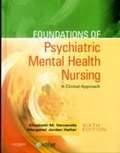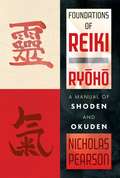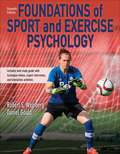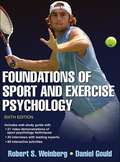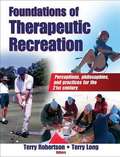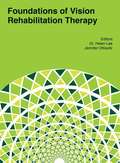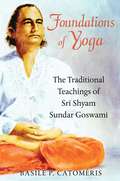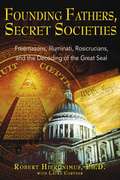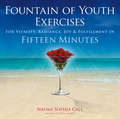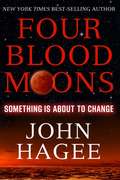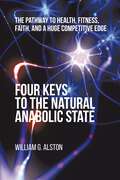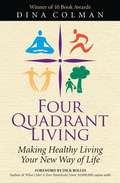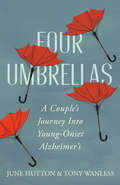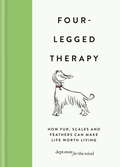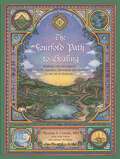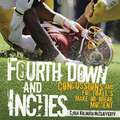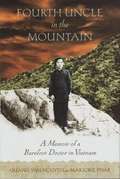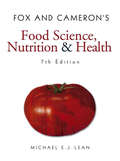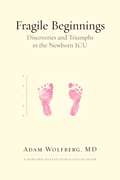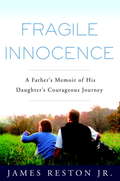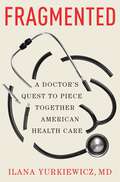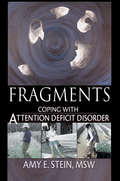- Table View
- List View
Foundations of Psychiatric Mental Health Nursing: A Clinical Approach (6th Edition)
by Elizabeth M. Varcarolis Margaret Jordan HalterThe 6th edition of this textbook offers a clear, straightforward way to understand the often intimidating subject of psychiatric mental health nursing. Its practical, clinical perspective and user-friendly writing style help you quickly master key concepts. Clinical chapters follow the nursing process framework and progress from theory to application with a wealth of real-world examples to prepare you for practice.
Foundations of Psychiatric Sleep Medicine
by John W. Winkelman David T. PlanteSleep-related complaints are extremely common across the spectrum of psychiatric illness. Accurate diagnosis and management of sleep disturbances requires an understanding of the neurobiological mechanisms underlying sleep and wakefulness, the characteristics of sleep disturbance inherent to psychiatric illness and primary sleep disorders, as well as the psychopharmacologic and behavioral treatments available. Foundations of Psychiatric Sleep Medicine provides a uniquely accessible, practical, and expert summary of current clinical concepts at the sleep-psychiatry interface. Topics covered include: basic principles in sleep science, clinical sleep history taking, primary sleep disorders in psychiatric contexts, and sleep disturbance across a range of mood, anxiety, psychotic, substance use, cognitive and developmental disorders. Written by outstanding experts in the field of sleep medicine and psychiatry, this academically rigorous and clinically useful text is an essential resource for psychiatrists, psychologists and other health professionals interested in the relationship between sleep and mental illness.
Foundations of Reiki Ryoho: A Manual of Shoden and Okuden
by Nicholas PearsonA comprehensive guide to the first and second degrees of Usui Reiki Ryoho as well as Reiki’s history and Western evolution • Details hand positions, self-healing exercises, spiritual development meditations, and the Japanese Reiki techniques introduced in the first degree, shoden, and the second degree, okuden • Provides a thorough introduction to the five levels of byosen, the energetic mechanism used to scan an individual’s energy field and locate areas of disharmony • Examines the core teachings of Reiki founder Usui Mikao and offers a new comprehensive exploration of Reiki’s history and evolution • Explores tools and techniques adapted by Western lineages, such as working with crystals and the chakras Bridging Eastern and Western lineages to reclaim Reiki’s roots as both a healing art and a spiritual practice, Nicholas Pearson offers a new comprehensive exploration of Reiki’s history and evolution, the foundations of Usui Reiki Ryoho theory and practice, and the original techniques and modern tools of both the first degree, shoden, and second degree, okuden. He explores the etymology of key Reiki terminology and presents a complete discussion of the origins of the symbols used in the second degree, providing new historical, cultural, and spiritual context. He examines the core teachings of Reiki founder Usui Mikao, who taught that Reiki Ryoho enacted healing at the soul level, as well as insights from other important Reiki masters such as Hawayo Takata. Explaining what Reiki is and how it heals, the author outlines the six core characteristics that all varieties of Reiki share, including initiations and the Five Precepts. He details effective hand positions, self-healing exercises, spiritual development meditations, and the Japanese Reiki techniques introduced in first degree and second degree practice. He also explores a number of other techniques that have been adapted by Western lineages, such as aura sweeping, chakra tune-ups, and charging and programming crystals with Reiki. He provides a thorough introduction to the five levels of byosen, the energetic mechanism used to scan an individual’s energy field and locate areas of disharmony, allowing you to increase your ability to sense centers of toxic imbalance as well as begin dislodging them, thereby increasing the effectiveness of Reiki treatment. Offering Reiki tools to transform your life from the inside out, Pearson shows how Reiki Ryoho is a healing system that focuses on the inner and spiritual aspects of your being first, allowing you to polish the heart so it reflects the shining light of the soul.
Foundations of Sport and Exercise Psychology
by Robert Weinberg Daniel GouldThe leading textbook in sport and exercise psychology is back in a revised seventh edition, and it again raises the bar with its engaging introduction to the field. Foundations of Sport and Exercise Psychology, Seventh Edition With Web Study Guide, offers a comprehensive view of sport and exercise psychology, drawing connections between research and practice and capturing the excitement of the world of sport and exercise. <P><P>Internationally respected authors Robert Weinberg and Daniel Gould continue to gather and incorporate feedback from teachers and students with each edition, building a text that addresses emerging trends and remains relevant and up to date. In-depth learning aids have been refreshed to help students think more critically about applying the material. Other updates to the seventh edition include the following: <P><P>A new chapter on diversity and inclusion addressing topics related to gender, ethnicity, race, sexual orientation, and disability New content on popular and emerging areas such as grit, mindfulness, organizational sport psychology, and technology in sport psychology Additional modern-day practical examples and anecdotes to better illustrate concepts Updated references, including more contemporary sources.
Foundations of Sport and Exercise Psychology (6th Edition)
by Robert Weinberg Daniel GouldAs the leading text in sport and exercise psychology, "Foundations of Sport and Exercise Psychology, Sixth Edition With Web Study Guide," provides a thorough introduction to key concepts in the field. This text offers both students and new practitioners a comprehensive view of sport and exercise psychology, drawing connections between research and practice and capturing the excitement of the world of sport and exercise. The internationally respected authors have incorporated feedback from teachers and students to create a text that builds on previous editions, making the material accessible to readers. In-depth learning aids have been refreshed, including chapter objectives and summaries, sidebars, key terms, key points, anecdotes, and discussion questions to help students think more critically about applying the material. Other updates to the sixth edition include the following: - More than 40 new video clips integrated into the web study guide to better demonstrate the core concepts addressed in the book - Additional emphasis on hot topics, including mindfulness, cultural diversity, ethics and professional issues, and transitions in sport - New ancillaries to help instructors teach their courses, including an image bank, chapter quizzes, and more than 122 instructor videos - Updated references, including more contemporary sources The text provides students with a unique learning experience--taking them on a journey through the origins and goals, key concepts, research development, and career options available in the field--in seven parts that may be studied in any sequence. Following an introduction to the field, the text then shifts focus to personal factors that affect performance and psychological development in sport, physical education, and exercise settings. Situational factors that influence behavior, group interaction and processes, and the use of psychological techniques to help people perform more effectively are covered, as well as the roles psychological factors play in health and exercise. The final section deals with topics of psychological development and well-being that are important to both society and sport and exercise psychology, including children's psychological development through sport participation, aggression in sport, and moral development and good sporting behavior in sport and physical activity contexts. The updated web study guide serves as an important learning tool to support the educational journey. With more than 100 engaging activities, it works directly with the text in guiding students to complete the related activities for each chapter and apply knowledge gained from the text. The study guide activities require students to do the following: - Use actual sport and exercise psychology instruments to assess their skills. - Determine how to respond to real-life scenarios (with short answers or essays). - Review research studies and experiments. - Search the Internet for relevant information. - Apply and test their understanding of principles and concepts of sport and exercise psychology. Many of the study guide activities offer compelling audio and video clips that provide an interactive look at how sport psychology consultants communicate with athletes and coaches to improve athletic experiences. These clips feature esteemed experts from the field discussing course concepts that they have studied and refined during their professional careers. To further emphasize practical application, portfolio activities can be integrated through a full semester, turning course units into a unified whole that builds upon itself for greater understanding of the field. To aid instructors, instructor ancillaries have been updated and expanded. The instructor guide, test package, and presentation package are now supplemented with an image bank, gradable chapter quizzes, and instructor videos, all available at www. HumanKinetics. com/FoundationsOfSportA
Foundations of Therapeutic Recreation
by Terry Robertson Terry LongFoundations of Therapeutic Recreation provides readers with a comprehensive introduction to the profession. The book draws on the combined wisdom, experience, and technical expertise of 23 professors and leaders in the field. From these contributors, readers gain access to diverse perceptions, philosophies, and practices for therapeutic recreation in the 21st century. The book showcases how the profession addresses various clients' needs throughout the life span through therapeutic programs, modalities, and activities. It also presents a wide range of applications, allowing readers to explore their personal and professional options; provides insight into the basic knowledge, attributes, and skills students need in order to thrive in the field; and delineates career paths in the profession and how a therapeutic recreation specialist works with various populations. Edited by Dr. Terry Robertson and Dr. Terry Long, Foundations of Therapeutic Recreationhas a comprehensive vision. The contributors present the broad scope of therapeutic recreation as research and practice across a diverse demographic of clients and consumers. The contributing authors explore various perspectives on therapeutic recreation and present standards and certification information that prepare students for the profession. Part I defines therapeutic recreation as a profession and provides an overview of its history and of the professional opportunities available. Part I also explores the profession's person-first philosophy and outlines the therapeutic recreation process as well as its models and modalities of practice and its allied professions. Part II delves into trends and issues, looking at demographics, economics, politics, and legislation as they affect the profession. It details international issues and paradoxes and concludes with future perspectives. Part III examines mechanisms for intervention from a number of perspectives, including orthopedic and neurological impairment, developmental disabilities, mental health, youth development, aging, and wellness. Foundations of Therapeutic Recreation contains chapter discussion questions to expand students' learning as well as Outstanding Professionals and Client Portraits sections to help students gain insight into various career paths. The book is accompanied by an instructor guide, PowerPoint presentations, and a test package available via the text's Web site to support the classroom instruction and enhance learning. The entire package gives students a solid grounding in the profession as it is today and a clear understanding of where the profession is headed tomorrow.
Foundations of Vision Rehabilitation Therapy
by Helen Lee Jennifer OttowitzFoundations of Vision Rehabilitation Therapy continues the legacy of Paul Ponchillia and Sue Ponchillia's seminal work Foundations of Rehabilitation Teaching with Persons Who Are Blind or Visually Impaired. After it was published in 1996, that book quickly established itself as an essential reference for vision rehabilitation professionals. Foundations of Vision Rehabilitation Therapy builds on that important work, reflecting changes in terminology and technology, while also incorporating best practices based on the past decades of evidence. It reflects the contemporary understanding of adult learning and skill building, providing proven techniques to help people with visual impairments develop skills and gain confidence that will equip them to lead independent, fulfilling lives.
Foundations of Yoga: The Traditional Teachings of Sri Shyam Sundar Goswami
by Basile P. CatomérisA guide to the complete yogic teachings of Sri Shyam Sundar Goswami by his disciple and spiritual heir • Shows how to enrich your physical Yoga practice by embracing and integrating Hatha Yoga’s metaphysical, spiritual, and psychological traditions • Explores the energy-focusing movements known as mudras and purification methods that can boost metabolism, reinforce muscles, and facilitate advanced sexual practices Foundations of Yoga presents the full and rigorous yogic training of traditional Hatha Yoga as taught by renowned Indian Yoga master the late Sri Shyam Sundar Goswami. Written by his disciple and spiritual heir, the book emphasizes metaphysical, spiritual, and psychological cultivation in addition to physical practice. It offers Yoga practitioners and teachers a way to enrich and advance their physical Yoga practice through a deeper understanding of physiology, psychology, philosophy, and spirituality centered on vedic and tantric principles. Woven together with stories from Sri Shyam Sundar Goswami’s life, the book explains pratyâhâra (control of the senses), châranâ (yogic bodybuilding), mental concentration exercises, and the energy-focusing and purifying muscular-control movements known as mudras, including the metabolism-boosting mahamudra and advanced pelvic mudras and sexual practices to transcend the ego. The book explores methods of internal purification such as dhauti (cleansing of the stomach with air or water), vasti (intestinal cleansing), neti (nasal cleansing), trâtaka (visual concentration exercises), and kapâlabhâti (diaphragmatic hyperventilation) and shows how these purifications are necessary before beginning the advanced breathing practices of prânayâma to eradicate deep internal impurities and strengthen the immune system. Exploring the philosophy of Yoga, the book shares meditative exercises for introspection, expanding consciousness, and seeking your true divine nature. As the teachings and life of Sri S. S. Goswami show, by strengthening the body, vital force, and mind, one can master all three for a long, healthy, harmonious life.
Founding Fathers, Secret Societies: Freemasons, Illuminati, Rosicrucians, and the Decoding of the Great Seal
by Laura E. Cortner Robert HieronimusAn exploration of the influence of secret societies on the formative documents and symbols of the United States• Reveals the Founding Fathers’ spiritual vision for America as encoded in the Great Seal• Traces the influence of the Iroquois League of Nations upon the Constitution• Exposes the deep connections the Founding Fathers had with the Freemasons and other secret societiesAll children growing up in America learn who the Founding Fathers were. Most, however, never learn of the founders’ connections to the Freemasons, the Rosicrucians, and other esoteric orders. In Founding Fathers, Secret Societies Robert Hieronimus investigates these important connections and how their influence can be traced throughout our most significant national documents and symbols, especially the Great Seal. He reveals in detail how the reverse of the Great Seal--which appears on the back of the one-dollar bill--is a blueprint that conveys the secret destiny of America. By understanding the kabbalistic meaning of the Great Seal’s reverse, he shows how our current era presents unique opportunities for the fulfillment of our Founding Fathers’ spiritual vision.
Fountain of Youth Exercises
by Naomi Sophia CallDrawing upon the ancient wisdom of Tibetan monks, yoga practitioners, and indigenous people, this manual for aging is an informative and inspiring guide for coaching those in the second half of life to feel and look great. A combination of do-in-an ancient technique of self-massage that strengthens the chi and circulation and warms the body from the inside out-yoga poses, and breathing exercises, this program offers a simple approach that can be done in the comfort of the home. An immediate understanding of how to breathe will help practitioners live in a more conscious and efficient way, and the poses will build confidence for a healthier, longer life. A well-researched study, this is an invaluable tool for nourishing an aging inner and outer radiance.
Four Blood Moons: Something Is About To Change
by John HageeInspired by NASA projections and recorded history, Pastor John Hagee reveals direct connections between four upcoming blood-moon eclipses and what they portend for Israel and all of humankind. Hagee divides the book into three sections. In Section 1, he explains the importance of Israel; in Section 2, he discusses the current distressed state of the world, expounds on the Gospel message of salvation, and describes his view of the Rapture; and in section 3, he elucidates upon the Blood Moons of the past and present and shows their relationship to the Jewish Biblical feasts of Passover and the Feast of Tabernacles. Throughout the book, Hagee encourages his readers to attend fervently to the signs in the heavens and to become ready for the events of the future. For those readers interested in Biblical prophecy and in end-time discussions, they should read this book to learn about the current thinking that is espoused by some Christians and by some Messianic Jews and Gentiles.
Four Centuries of American Herbs
by Patricia B. MitchellDescriptions of various herbs, recipes, lore, instructions for drying, quotable quotes, and extensive endnotes.
Four Keys to the Natural Anabolic State: The Pathway to Health, Fitness, Faith, and a Huge Competitive Edge
by William G. AlstonThis book reveals a stunning thread of scientific data that points the way to the natural anabolic state--a biochemical condition wherein body fat is metabolized, muscle tissue is built, strength and speed are increased, mental acuity is enhanced, and the
Four Quadrant Living: Making Healthy Living Your New Way of Life
by Dina ColmanLiving healthy doesn't need to be complicated. Four Quadrant Living shows readers how to take responsibility for their own health by providing logically organized and easily implemented ideas and suggestions for nourishing the "four quadrants" of our lives. The book includes ways to reduce stress, live mindfully, eat well, exercise more, sleep better, engage in healthy relationships, and detoxify environments. Many people worry about getting cancer, diabetes, Alzheimer's disease, or heart disease because it "runs in the family." This attitude encourages a passive, out-of-my-hands approach. Instead, Four Quadrant Living offers a new prescription for health, one that emphasizes positive steps readers can take to make healthy living a part of their daily routine. Four Quadrant Living provides simple, effective, and natural ways to help readers take control of their health so that they feel empowered, beat the odds, and live radiantly. We may be eating well and exercising, but we cannot truly be healthy if our mind is stressed, our relationships are toxic, and our world is sick. Every day we make choices that impact our health-the foods we eat, the products we use, the exercise we get, the stress we allow, the people we surround ourselves with, and the environment we live in. Four Quadrant Living guides readers to make healthy living a part of their daily lives, leading to abundant health, vitality, and happiness.
Four Umbrellas: A Couple's Journey Into Young-Onset Alzheimer's
by June Hutton Tony WanlessA writing couple searches for answers when Alzheimer's causes one of them to lose the place where stories come from — memory. At the age of fifty-three, Tony walks away from a life of journalism and into an unknown future. June is forty-eight, a writer and teacher, and over the following decade watches as her husband changes — in interests, goals, and behaviour — until Tony has a fall, ending the life they had known. A diagnosis is seven years away, yet the signs of Alzheimer’s are all around. A suitcase Tony packs for a trip is jammed with four umbrellas, a visual symbol of cognitive looping. But how far back do these signs go? The couple starts probing the past and finding answers. This is not an old person’s disease.
Four-Legged Therapy: How fur, scales and feathers can make life worth living
by Department Store for the MindA WORDLESS LISTENER, A REASON TO GO OUTSIDE, AN INTENSE SURGE OF JOY...What healthy habits can we learn from our fluffy, scaly and, let's face it, stinky companions? Is it just the companionship and love or is there more to it?Discover the myriad ways in which our pets and other animals can help us feel more present and connected in our lives, how they literally save lives and also make life more worth living. From the 'hensioners' who look after ex-battery chickens to 'goat club', dogs who listen to children learning to read and Mitzpah the collie who just knows how to make people smile. There is a world of therapy out there, waiting to sit on your lap.
Four-Legged Therapy: How fur, scales and feathers can make life worth living
by Dept LtdFour- Legged Therapy is a delightfully illustrated collection of ten stories that recognise the therapeutic value of having animals in our lives. A charming exploration of how pets can support our minds and bodies in everyday life. From grumpy cats, fat dogs and muddy ducks to goats in a classroom and rescue-hens in a care home, this book recognises animals as the unsung heroes that save lives and make life worth living. Animals offer companionship, love and fun. They teach us the gift of kindness and acceptance. They can connect us to the world, slow down time and sharpen our senses in a kind of informal meditation. They can be good listeners, offering reassurance and devotion that steadies our self-esteem. They ask us for routine and consistency, to show a kind of resilience that is good for us."Your dog's utter faith in your humanity will make you feel like more and more of a human, every day"- Caroline O'Donoghue, author of 'Promising Young Women', shortlisted for the Irish Book Awards writing about the joy of unconditional from her Jack-Russell terrier, Sylvie. "I feel as if I've been permitted a glimpse into the wonder at the very heart of life, led there by my dog" - Rabbi Jonathan Wittenberg, author of Things My Dog Has Taught Me: About being a better human.
Fourfold Path To Healing: Working with the Laws of Nutrition, Therapeutics, Movement and Meditation in the Art of Medicine
by Mcmillan Sally Fallon CowanThe Fourfold Path to Healing merges the wisdom of traditional societies, the most modern findings of western medicine and the esoteric teaching of the ancients. The fourfold approach includes: Nutrition using nutrient-dense traditional foods; therapeutics through a wide range of nontoxic remedies; Movement to heal and strengthen the emotions; and medication to develop your powers of objective thought.
Fourth Down And Inches: Concussions And Football's Make-or-break Moment
by Carla Killough McclaffertyAward-winning author Carla Killough McClafferty takes readers on a bone-crunching journey from football's origins to the latest research on concussion and traumatic brain injuries in the sport.
Fourth Uncle in the Mountain: A Memoir of a Barefoot Doctor in Vietnam
by Marjorie Pivar Quang Van NguyenSet during the French and American wars, Fourth Uncle in the Mountain is a true story about an orphan, Quang Van Nguyen, who is adopted by a sixty-four year old monk, Thau, who carries great responsibility for his people as a barefoot doctor. Thau manages, against all odds to raise his son to follow in his footsteps and in doing so, saves his son, as well as a part of Vietnam's esoteric knowledge from the Vietnam holocaust. <p><p> Thau is wanted by the French regime, and occasionally must flee into the jungle, where he is perfectly at home living among the animals. Thau is not the average monk; he practices an ancient lineage of Chinese medicine and uses magic to protect animals and help people. <p><p> As wise and resourceful as Thau is, he meets his match in his mischievous son. Quang is more interested in learning Cambodian sorcery and martial arts than in developing his skills and wisdom according to his father's plan. <p><p> Fourth Uncle in the Mountain is an odyssey of a single-father folk hero and his foundling son in a land ravaged by the atrocities of war. It is a classic story, complete with humor, tragedy, and insight from a country where ghosts and magic are real.
Fox and Cameron's Food Science, Nutrition & Health
by Michael EJ LeanThe seventh edition of this classic book has been entirely revised and updated by one of the leading professors of human nutrition in the UK. Written in a clear and easy-to-read style, the book deals with a wide range of topics, from food microbiology and technology to healthy eating and clinical nutrition. It also tackles the more difficult area o
Fragile Beginnings
by Adam WolfbergThis is a gripping medical narrative that brings readers into the complex world of newborn intensive care, where brilliant but imperfect doctors do all they can to coax life into their tiny, injured patients. Dr. Adam Wolfberg--journalist, physician specializing in high-risk pregnancies, and father to a child born weighing under two pounds--describes his daughter Larissa's precipitous birth at six months, which left her tenuously hanging on to life in an incubator. Ultrasound had diagnosed a devastating hemorrhage in her brain that doctors reasoned would give her only a 50 percent chance of having a normal IQ. As they make decisions about live-saving care in the first hours of a premature infant's life, doctors and parents must grapple with profound ethical and scientific questions: Who should be saved? How aggressively should doctors try to salvage the life of a premature baby, who may be severely neurologically and physically impaired? What will that child's quality of life be like after millions of dollars are spent saving him or her? Wolfberg explores the fits and starts of physicians, government policy makers, and lawyers who have struggled over the years to figure out the best way to make these wrenching decisions. Through Larissa's early hospital course and the struggle to decide what is best for her, Wolfberg examines the limitations of newborn intensive-care medicine, neuroplasticity, and decision making at the beginning of life. Featuring high-profile scientific topics and explanatory medical reporting, this is the first book to explore the profound emotional and ethical issues raised by advancing technology that allows us to save the lives of increasingly undeveloped preemies.
Fragile Innocence: A Father's Memoir of His Daughter's Courageous Journey
by James Reston Jr.Fragile Innocence is the story of a child devastated by pure chance. This moving narrative of a father's journey to understand and accept the profound changes in his daughter's life is at once memoir, biography, mystery, and drama, all centered around one remarkable young woman who cannot talk or read or understand language, but who has touched almost everyone she has ever met. At eighteen months Hillary Reston, a happy, healthy toddler, was struck by a remarkably high fever. On the advice of her doctor, her parents, James Reston, Jr., and Denise Leary, administered Tylenol and anxiously waited for the fever to subside. Five days later it did, but the damage was done. Over the course of the next five months their bubbly, highly verbal child was radically and irrevocably changed. Worse yet, no doctor could explain what evil and still unidentified force had stolen Hillary's ability to speak or understand language, hurtled her into a seemingly endless cycle of seizures, destroyed her kidneys, and taken her to the very brink of death.For her parents, discovering what had happened to their child and how to assure the quality of her life became an obsession. This quest for answers would take them from the nation's hospitals to the office of a pioneering geneticist in Texas and the vaulted halls of the National Institutes of Health.This very intimate story also personalizes some of the most daunting ethical issues of medicine that society faces today, including stem cell research, animal organ transplantation, diagnosis with the Human Genome Map, and reproductive and therapeutic cloning. Hillary gives these immensely complicated issues a human face, and they are pondered by Reston as a reporter, a thinker, and a father. In Fragile Innocence author James Reston, Jr., invites us inside his family, candidly sharing the joys and sorrows of raising Hillary."This is a book about the first twenty-one years of a child named Hillary. It tells of her battle to live and our family's struggle to help her survive as best we could, after an evil and still unidentified force robbed her of her language at the age of two, hurtled her into a seemingly endless cycle of brain storms, destroyed her kidneys, and took her to the very brink of death. That is the first half of the story, when life itself was at stake." --From the Preface.
Fragmented: A Doctor's Quest to Piece Together American Health Care
by Ilana Yurkiewicz MDAn award-winning physician-writer exposes how pervasive cracks in the health care system cost us time, energy, and lives—and how we can fix them. There’s an unspoken assumption when we go to see a doctor: the doctor knows our medical story and is making decisions based on that story. But reality frequently falls short. Medical records vanish when we switch doctors. Critical details of life-saving treatment plans get lost in muddled electronic charts. The doctors we see change according to specialty, hospital shifts, or an insurer’s whims. Physician Ilana Yurkiewicz calls this phenomenon fragmentation, and, she argues, it’s the central failure of health care today. In this gripping narrative from medicine’s front lines, Yurkiewicz reveals how a system that doesn’t talk to itself puts insupportable burdens on physicians, patients, and caregivers, forcing them to heroic lengths to hold the pieces together—barely. The stories she tells are at once harrowing and commonplace. A patient narrowly averts an unnecessary, invasive heart procedure by producing a worn rhythm strip he has carried in his pocket for a decade. A man diagnosed with leukemia while visiting from abroad has thirty-one physicians, but no one he can call “his” doctor, with tragic consequences. When Yurkiewicz’s own father falls ill, a culture that incentivizes health care providers to react with quick fixes to the problems immediately before them—often to the neglect of a patient’s overall narrative—leads to weeks of additional suffering and a risky hospital transfer. The system is hanging by a thread, and we need better solutions. Yurkiewicz issues a clear-eyed call for change, naming concrete reforms doctors and policymakers can make, and empowering patients and their loved ones to advocate for themselves in the meantime. Urgent, radiantly humane, and ultimately hopeful, Fragmented a prescription for what really needs fixing in modern medicine.
Fragments: Coping with Attention Deficit Disorder
by Amy E SteinExplore effective alternative approaches to improving the lives of those diagnosed with attention deficit disorder!This remarkable new book offers fresh perspectives on ADD/ADHD. Even more important, it provides new direction for sufferers, introducing an ecologically based lifestyle that focuses on hands-on interactive learning. Fragments: Coping with Attention Deficit Disorder shows how to use environmental education and activities such as organic farming, community service, mission work, art, yoga, meditation, and spirituality to bring about positive change in people diagnosed with ADD or ADHD.From author Amy E. Stein: “This book is about life. It is written for those who think they have no hope, who struggle with life, with decisions, with addiction, and in search of themselves. I do not believe traditional psychotherapy or medication are solutions for those of us who fall under the label of ADD or ADHD.”Candidly written by a woman who, at age 25, was diagnosed as “a textbook case for attention deficit hyperactivity disorder,” this insightful book examines: the pitfalls of traditional psychotherapy and medication for those diagnosed with ADD/ADHD how an interactive hands-on learning environment can markedly improve the educational experience of ADD/ADHD kids how an organic, holistic approach can benefit those diagnosed with ADD/ADHD the correlation between agriculture and ADD/ADHD and the impact of eliminating pesticides and increasing fatty acid intake in the diets of sufferers how incorporating spirituality and faith into ADD/ADHD sufferers&’ lives can help to add discipline and bring greater satisfaction and much more!Five helpful appendices give you easy access to environmental education resources, agricultural resources, a sample agricultural curriculum, a sample ecology curriculum, and an environmental art curriculum.
